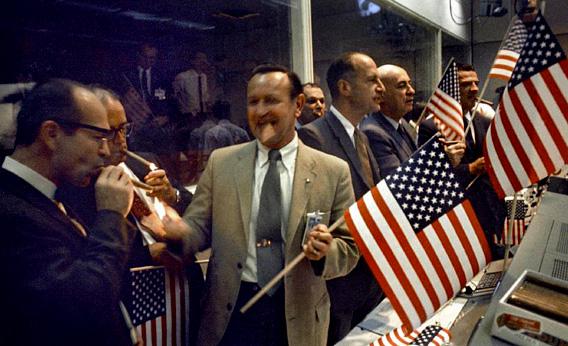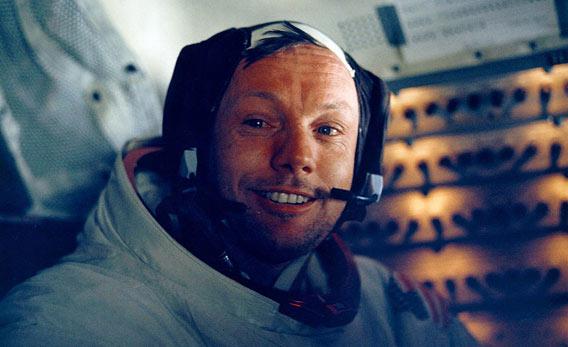I always hoped I would be alive to see the first man walk on the moon. I was, and I got to write about it.
I never thought I also would be alive to see the last man land on the moon.
I covered Neil Armstrong when he first stepped foot on the lunar surface, and even helped shape what history remembers as his first words (more on that later). I covered all the other lunar landings up until the last, Apollo 17, for both Reuters and the Philadelphia Inquirer. It never occurred to me at the time that the America that sent men to the moon would shrink back onto itself and that the spirit that pushed the frontier was a temporary aberration. Now we fire school teachers to save a dime.
Armstrong died last week at 82. Buzz Aldrin, who went with him to the surface, and Michael Collins, who circled above them in the Apollo command module, are still alive. We sent a total of 24 men to the moon, and 12 of them walked on the surface. One of them, Alan Shepard, even played golf up there. All the other living moon-walkers are now in their 70s or 80s. If anyone ever goes back, I’ll be long gone. Ten years from now there likely will be no one alive who walked on another world. I find that lamentable.
As Armstrong said, “that’s one small step for man, one giant leap for mankind.”
Or did he?
Let’s clear that up first. Except for the lunatics who think the whole thing was staged on a Hollywood set, that quotation is about the only controversy left. To be blunt, it doesn’t matter if he really said that. A small group of us said he did and that ends it.
Reporters covering the space program worked in a large room at the Manned Space Center in Houston, a public display hall converted into a press center. It was a time before computers or cellphones. Every desk was assigned and each had a telephone. We wrote the stories on portable typewriters (almost all, for some reason, light green Olivettis) and dictated to our offices over the phone, although those of us at the wire services had access to Teletype machines.

NASA.
One of the perks was that we could hear the air-to-ground transmissions from the spacecraft on earphones. We could hear—at least in theory—every word spoken between the astronauts and mission control. (They could make the transmissions private if they needed to talk about bowel movements or impending death, but they didn’t do that often).
On July 20, 1969, we sat mesmerized at our typewriters, glancing up at television screens on the walls, hands poised. “The Eagle has landed,” announced Armstrong, and fingers flew. Reuters sent out a flash, bells clamoring: “Men on the moon.”
Eventually Armstrong climbed down the lunar module’s ladder and set foot on the surface, a step guaranteed to put his name in every history book ever. And then he said either “that’s one small step for man, one giant leap for mankind,” or “that’s one small step for a man, one giant leap for mankind.” The transmission was not clear and we were not sure we heard the word “a” before the word “man.”
Now we had problem and no time to think about it. Clearly, this was to be one of the most famous quotations in history and we had to get it right. More important at the moment, we had to be consistent. We could not have one news service say one thing, the other two something else, or have the New York Times have one version and the Washington Post another. Forget history, we had to deal with editors.
A small group of us from the wire services and the major papers gathered quickly in the middle of the press room and decided the “a” was missing. It went out that way to all our readers and that is the quote everyone knows.
Later, Armstrong insisted that he knew what he was going to say before he climbed down the ladder and that he said the “a” word. But when NASA cleaned up the recording of the transmission, it was clear we were right and he was wrong. He simply forgot to say it.

NASA/Newsmakers.
Make no mistake, it was a giant leap for mankind, and one for America too. The main motivation for John Kennedy’s moon program was the Cold War and competition with the Soviet Union, but it became far more than that.
It also became the largest and most successful government peaceful stimulus package in American history. You would have to go back to the funding for the transcontinental railroads in the 19th century to find an equal.
The government pumped $25 billion (about $170 billion today) into the quest to send Americans to the moon. That does not include the funding for Gemini and Mercury, the programs that set up Apollo. The old canard from critics was, “why are we spending all that money on the moon when we could be spending it here in America?” We were, of course, spending almost every dime of it in America.
At its peak, Apollo employed 400,000 people directly in the government or through contractors, and hundreds of thousands more indirectly. Many of those people were our best engineers and scientists, skilled technicians, and even talented bureaucrats. NASA in the 1960s and early 1970s is still the most efficient government agency I have ever encountered. Every time I hear a politician say the government can’t do anything very well, I think of them.
It was a triumph of nerds and test pilots.
For the money, we got the greatest technological achievement in history. One of the myths surrounding the space program is that it led to the invention of mundane advances like Teflon and Velcro, neither of which is true, although both were used. The advances were far greater than that.
What it generated is much of the electronic age we live in, the way we build computers and electronics, how we program them, how we organize them. The first fuel cells flew in Apollo. Much of the early work in integrated circuits derived from solving technical problems in flying men to the moon and returning them. With every mission, the computers got smaller and more powerful.
It is absolutely true that the laptop computer I am using to write this has more computing power than the computers that flew to the moon, but I would not be writing on it now had those computers not gone there then.
The scientific results were staggering. We could hold pieces of the moon in our hands—and I did—and study them. As a result, we know far more about the origin of the solar system and our Earth than we knew before.
The economy boomed as a result of the technological advances and the money the government pumped into it.
One more thing: The world changed because of one photograph taken by the Apollo 17 crew, the famous Blue Marble photo of the Earth, sitting alone in the blackness of space, green and blue and vulnerable. Along with Rachel Carson’s book Silent Spring, it molded our view of the fragility of our planet and led to the environmental movement. No one predicted that.
It is estimated that one-fifth of the human population of Earth saw the landing on television, saw Armstrong plant the American flag.
But none of that was sufficient reason to go then, or to go now. There is a greater reason.
The late Jonathan Eberhart of Science News, a friend and colleague, in one brilliant column cut through it all. We should explore space because that’s what we humans do, he wrote. We explore. We are not content with where we are, we want to see what is over there. It is part of our DNA.
When the great explorations of Earth began, there probably were people who told Cook and Magellan and Hudson and Columbus and all the rest that it was a waste of resources or that if God wanted us to find a northwest passage, he would have put up road signs or something. But they went. That’s us. We have the capacity (and as the modern-day analog to the old empires, “we” is mostly the United States) to do it.
What we now lack is the will and courage. What if we decided to go to Mars? How is that for a stimulus package?
Neil Armstrong and the Apollo program were the marks of a nation in its ascent or at its most powerful. And now?
